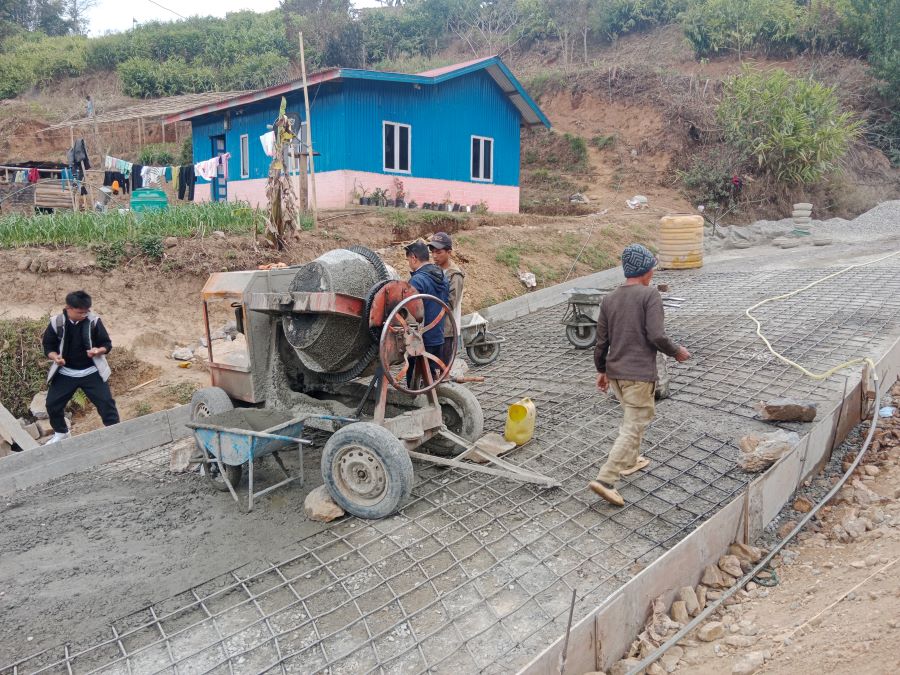Ilam. It feels like a dream to Tulsiram Adhikari, 93, of Suryodaya-1 Makarjung, to see the road near his yard being blacktopped. Standing by the roadside and looking at the road being upgraded, Adhikari said, “I never imagined that the roads in our village would be this bad. It feels like a dream or a nightmare.”
Not only him, but almost all the citizens here, who have been plagued by mud, dust and potholes, are excited after the local government started upgrading the roads. There is one ‘all-weather’ road in each ward of Suryodaya Municipality. The municipality, which started the upgrade by prioritizing the ‘all-weather road’ that will be operated year-round and connect all the villages in the ward, has now brought those roads to the blacktop stage. Roads in the village are being blacktopped in a big way.
Suryodaya Municipality has 333 local roads, including 13.5 kilometers of blacktopped roads, 83.8 kilometers of gravel roads, and 668.93 kilometers of paved roads. These roads have been classified into ‘A’, ‘B’, ‘C’, and ‘D’, said Kabin Sapkota, the municipality’s civil engineer.
According to him, there are three major roads under the Strategic Road Network (SRN) within the municipality. Of these, Mechi Highway, Fikkal-Pashupatinagar, and Chhipitar-Shriantu roads have blacktopped 48.20 kilometers, gravel 2.45 kilometers, and paved 2.41 kilometers. Suryodaya has 10.83 kilometers of blacktop, 16.12 kilometers of gravel and 36.56 kilometers of dirt roads under the ‘District Road Care Network’ (DRCN).
The municipality had prepared a municipal road network master plan four years ago as per the plan to construct its roads within the city in a manner that allows vehicles to operate for 12 months. According to the master plan, the roads within the city will be constructed in 28 years.
Mayor Rana Bahadur Rai said that the municipal road network master plan has been prepared to improve the living standards of the people by constructing roads in a systematic and planned manner. “If the road construction work was done in the old style, it would take 128 years to completely gravel the roads within the city,” he said. We had started the construction of road infrastructure by making a master plan for the systematic upgrading of roads leading to people’s homes. Now, work is underway in full swing.
After the local level elections, the people’s representatives prioritized the construction of one gravel road per ward, and the work of graveling one road per ward in all 14 wards of Suryodaya is underway, and now the blacktop stage has come, said Sapkota, civil engineer of the municipality.
It has been said that Rs 590 million will have to be spent every five years to gravel the roads within the city within 27 years. This amount is the cost of road survey, environmental protection, road widening and road upgrading. The master plan states that in five years, 5 percent of the 590 million rupees will be spent on environmental protection, 5 percent on survey design, 15 percent on road widening and 75 percent on road gravel. At the current rate, 3.2 billion rupees will have to be spent on gravel roads in urban areas.
After the roads in every village have started being blacktopped, it has become easier for farmers to transport their agricultural produce to the market. Santosh Bajgain of Suryodaya-1 collects the agricultural produce produced in the village and takes it to the Manebhanjyang market on the Indian border to sell it.
It has become easier for him to reach the market after the road was built, which used to take about three hours to travel on foot. ‘When the road was difficult, it took three to four hours on a horse. Now the road has become easier. There is no problem that the horse will drop its shoe. “It is now possible to travel by car even during the monsoon,” said Bajgain. Locals say that it has become easier for farmers in rural areas to reach the market, students to commute to school, and patients to reach the hospital immediately than in the past. Farmers say that the problem of farmers’ agricultural produce not reaching the market due to the lack of roads has ended.
“We have also had incidents of dairy products being wasted during the monsoon due to the lack of roads. Our tomatoes were too rotten to reach the market. We have got rid of that problem,” said farmer Khyamraj Rijal. Local Govinda Sapkota said that the municipality has started benefiting from the concept of one ward, one all-weather road and the construction of roads.
Deputy Mayor Durga Kumar Baral said that the municipality has moved forward with a sustainable development model by eliminating the traditional method of using machines to build roads and spreading confusion in the eyes of the people. “To change the traditional narrative that development is only about soil and roads, we have taken forward plans and programs in parallel for the development of the economic, social, environmental and good governance sectors,” he said. “To ensure the quality of infrastructure projects, an infrastructure testing laboratory has been established in the municipality itself, ensuring quality and increasing the scope of internal income.”
Farmers here produce a lot of milk after tea. The Bahramase road has provided great relief in transporting tea to local industries, milk to dairies, and agricultural products like potatoes, cardamom, ginger, squash, greens, and tomatoes to the market for sale. It has also become easier to reach the main trading places here, including Manebhanjyang, Pashupatinagar, and Phatak, which are connected to India. It has also become easier to reach the local, Fikkal, Harkate, Ainadare, and Gorkhe markets. Local farmer Saroj Pokharel said that in the past, the obligation to walk for one to five hours from some villages to reach these markets has been eliminated with the access to the road infrastructure.
According to the municipality, the maximum number of two-wheeled motorcycles have been operating on the roads of the urban area. 45 percent of motorcycles, 26 percent jeeps, 17 percent tractors, and 12 percent truck buses ply on municipal roads.
































प्रतिक्रिया दिनुहोस्